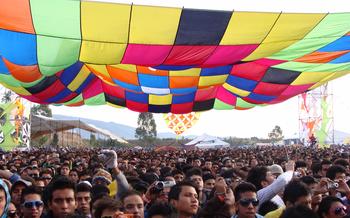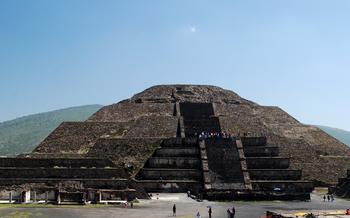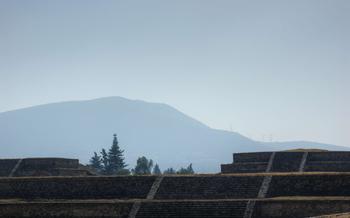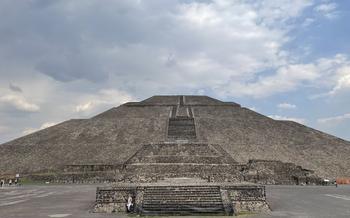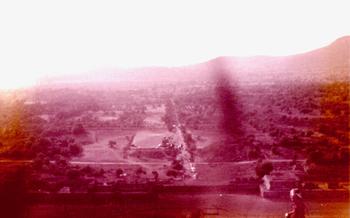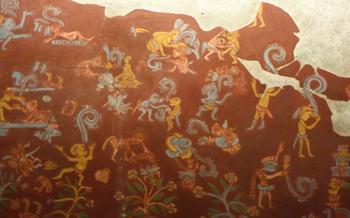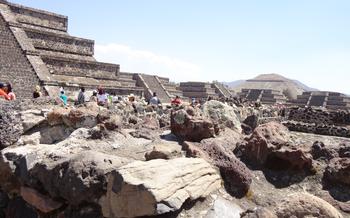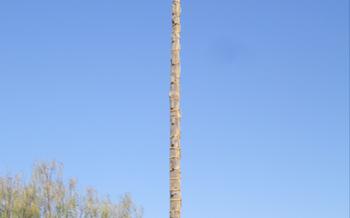
Temple of the Feathered Serpent (Quetzalcoatl)
- Temple of the Feathered Serpent (Quetzalcoatl): A Sacred Legacy
- A Journey Through Time: Exploring Teotihuacan
- Unveiling the Secrets of the Temple
- In the Footsteps of Ancient Rituals
- Awe-Inspiring Views: Climbing the Temple
- The Murals of Teotihuacan: A Visual Tapestry
- A Place of Worship and Pilgrimage
- The Feathered Serpent: A Divine Messenger
- Teotihuacan's Enduring Legacy
- Practical Tips for a Memorable Visit
- Unforgettable Experiences at the Temple
- The Mystery of the Feathered Serpent's Head
- Exploring the Avenue of the Dead
- The Temple's Role in Ancient Astronomy
- Insider Tip: Unveiling Hidden Treasures
Temple of the Feathered Serpent (Quetzalcoatl): A Sacred Legacy
In the heart of Teotihuacan, a city that once teemed with life and mystery, stands the Temple of the Feathered Serpent, a testament to the ingenuity and spirituality of ancient Mesoamericans. This colossal structure, also known as the Pyramid of Quetzalcoatl, is a marvel of engineering, showcasing the architectural prowess of a civilization that thrived centuries ago. Its history is shrouded in enigma, but its symbolic elements and cultural significance continue to captivate visitors from around the world.
The temple's colossal size and intricate carvings evoke awe and wonder. Its intricate carvings, depicting the Feathered Serpent, symbolize the convergence of the spiritual and earthly realms. Quetzalcoatl, a revered deity in Mesoamerican mythology, was associated with fertility, rain, and the wind, embodying the cyclical nature of life and the cosmos. The temple's orientation and alignment with celestial events further emphasize its profound connection to the heavens.
Over the years, restoration and preservation efforts have been meticulously undertaken to safeguard this iconic landmark. Archaeologists and conservators have worked tirelessly to protect the temple's integrity while preserving its historical and cultural significance for future generations. Visitors to this sacred site can marvel at the enduring legacy of Teotihuacan, immerse themselves in its rich symbolism, and gain a deeper understanding of one of the most awe-inspiring civilizations of the ancient world.
A Journey Through Time: Exploring Teotihuacan
Teotihuacan, a city shrouded in mystery, stands as a testament to the ingenuity and grandeur of ancient Mesoamerican civilizations. Its origins remain enigmatic, but its rise to prominence around the 1st century AD transformed it into a thriving metropolis and a significant religious center. At its peak, Teotihuacan was home to over 100,000 inhabitants, making it one of the largest cities in the pre-Columbian Americas.
The city's most iconic landmarks are the Pyramid of the Sun and the Pyramid of the Moon, towering structures that dominate the landscape. The Pyramid of the Sun, the largest building in Teotihuacan, stands at an impressive 213 feet tall and is believed to have been built as a temple dedicated to the sun god. The Pyramid of the Moon, slightly smaller in size, is thought to have been dedicated to the moon goddess.
The Avenue of the Dead, a wide, central boulevard that runs through the city, connects these two colossal pyramids. Along this grand thoroughfare lie various temples, palaces, and residential compounds, each contributing to the city's rich tapestry of architecture and symbolism.
Teotihuacan's buildings are adorned with intricate carvings and vibrant murals, showcasing the artistic prowess of its inhabitants. These artworks depict mythological scenes, religious rituals, and everyday life, providing valuable insights into the beliefs and culture of this ancient civilization.
The city's decline and eventual abandonment around the 7th century AD remain a subject of debate among scholars. While the exact reasons for its downfall are unknown, it is believed that a combination of factors, including environmental changes, political instability, and internal conflicts, may have contributed to its demise.
Despite its mysterious end, Teotihuacan's legacy continues to captivate and inspire. The city's awe-inspiring architecture, rich symbolism, and enduring influence on Mesoamerican cultures make it a must-visit destination for anyone seeking to delve into the depths of ancient history and human ingenuity.
Unveiling the Secrets of the Temple
The Temple of the Feathered Serpent stands out for its unique architectural features and distinct pyramid shape. Unlike other pyramids in Teotihuacan, it has a square base and a smaller, superimposed pyramid on top. This design creates a stepped effect that adds to the temple's visual appeal.
The temple's orientation and alignment are also significant. It faces west, towards the setting sun, which suggests its connection to the cult of Quetzalcoatl, the Feathered Serpent god associated with the planet Venus. The alignment with the sunset may have played a role in religious ceremonies and rituals, as the setting sun was believed to be a manifestation of Quetzalcoatl's descent to the underworld.
One of the most remarkable discoveries at the temple was the head of the Feathered Serpent, which was found buried at the base of the main pyramid. Carved from a single block of stone, the serpent's head is a masterpiece of ancient sculpture, depicting the god's distinctive features, including its feathered headdress and open mouth. The placement of the head at the base of the pyramid suggests its symbolic importance, possibly representing the god's emergence from the underworld.
Ongoing archaeological research and excavations at the temple site continue to shed light on its history and significance. Recent excavations have uncovered new structures and artifacts that provide valuable insights into the temple's construction, use, and symbolism. These discoveries contribute to our understanding of this iconic monument and its role in the ancient city of Teotihuacan.
In the Footsteps of Ancient Rituals
The Temple of the Feathered Serpent played a central role in the religious ceremonies and rituals of Teotihuacan's ancient inhabitants. It was believed to be the earthly home of Quetzalcoatl, the revered deity associated with fertility, water, and the wind. Elaborate rituals were conducted within the temple complex, often involving processions, offerings, and sacrifices.
The Feathered Serpent held a profound symbolic meaning in Mesoamerican culture. It represented the connection between the physical and spiritual realms, embodying the power of transformation and regeneration. Its presence in the temple underscored the sacredness of the site and its importance as a place of worship and pilgrimage.
The influence of Quetzalcoatl's cult extended beyond Teotihuacan, impacting other Mesoamerican civilizations. The Feathered Serpent motif and associated beliefs were adopted and adapted by various cultures, contributing to the rich tapestry of Mesoamerican mythology and religious practices.
The temple's location within the city's spiritual and political center further emphasized its significance. It served as a focal point for religious ceremonies and rituals, while also reinforcing the authority of the ruling elite. The temple's grandeur and ornate decorations reflected the power and prestige of Teotihuacan's ancient rulers.
Awe-Inspiring Views: Climbing the Temple
The Temple of the Feathered Serpent stands as a majestic testament to ancient architectural prowess, inviting visitors to embark on a challenging but rewarding climb to its summit. The ascent may test your endurance, but the breathtaking panoramic views that await at the top are well worth the effort. From this elevated vantage point, you'll be treated to an awe-inspiring vista that encompasses the entire ancient city of Teotihuacan. The vast expanse of the Avenue of the Dead stretches out before you, flanked by the imposing Pyramids of the Sun and Moon. The surrounding landscape, dotted with smaller temples and structures, completes this remarkable panorama.
For an unforgettable experience, time your climb to coincide with sunrise or sunset. As the golden rays of the rising sun illuminate the city, casting long shadows across the landscape, you'll feel a profound connection to the ancient past. Similarly, witnessing the sunset from the temple's summit is an equally magical experience. The sky transforms into a canvas of vibrant hues, painting the surrounding mountains and valleys in warm, ethereal light.
To ensure a safe and enjoyable climb, remember to wear comfortable shoes with good traction. The steps can be steep and uneven, so it's essential to take your time and maintain a steady pace. Bring along a bottle of water to stay hydrated, especially during the warmer months. And don't forget your camera to capture the breathtaking views from the top. The memories you create here will last a lifetime.
The Murals of Teotihuacan: A Visual Tapestry
The Temple of the Feathered Serpent is adorned with vibrant and well-preserved murals that offer a glimpse into the artistic and symbolic world of ancient Teotihuacanos. These murals, painted with natural pigments on a stucco base, depict a variety of scenes, figures, and symbols that hold deep cultural and religious significance.
One of the most striking murals is the "Procession of the Feathered Serpents," which depicts a line of feathered serpents moving in a sinuous pattern. This mural is believed to symbolize the journey of the soul through the afterlife, as the feathered serpent was often associated with death and resurrection.
Another notable mural is the "Mythical Animals and Plants," which features a variety of fantastical creatures, including jaguars, eagles, and monkeys, as well as plants and flowers. This mural is thought to represent the diversity and abundance of the natural world, which was sacred to the ancient Teotihuacanos.
The murals of Teotihuacan are not only visually stunning but also provide valuable insights into the beliefs, rituals, and mythology of this ancient civilization. They offer a glimpse into the minds of the artists who created them and the world they inhabited.
A Place of Worship and Pilgrimage
The Temple of the Feathered Serpent was not merely a monument but also a sacred site that held immense religious significance for the ancient Mesoamericans. It served as a place of worship, pilgrimage, and spiritual connection for people from all walks of life. The temple complex was designed to facilitate elaborate religious ceremonies and rituals that honored the gods and celebrated important events in the Mesoamerican calendar.
Archaeological excavations have revealed a wealth of offerings and artifacts within the temple, providing insights into the religious practices of the ancient city. These offerings included precious objects such as jade, gold, and turquoise, as well as pottery, textiles, and figurines. The discovery of these artifacts suggests that the temple was a place where people came to make offerings, seek divine guidance, and connect with the supernatural realm.
The temple's enduring spiritual significance extends beyond the ancient Mesoamericans. In contemporary times, the site continues to attract visitors from around the world who come to experience its sacred atmosphere and pay homage to the ancient gods. Many visitors find the temple to be a place of peace, reflection, and spiritual rejuvenation, fostering a sense of connection with the past and the divine.
The Feathered Serpent: A Divine Messenger
In the mythology of ancient Mesoamerica, Quetzalcoatl, the Feathered Serpent, was a revered deity associated with fertility, water, and the wind. His origins can be traced back to the ancient Olmec civilization, where he was known as the "Lord of the Dawn" and represented the morning star. As his cult spread throughout Mesoamerica, Quetzalcoatl's symbolism evolved, and he became associated with various aspects of life, including creation, knowledge, and rulership.
The Feathered Serpent motif, with its striking combination of avian and reptilian features, was a powerful symbol in Mesoamerican art and iconography. It adorned temples, sculptures, and other artifacts, representing Quetzalcoatl's divine presence and his connection to the natural world. The serpent's body often symbolized the earth, while its feathered wings represented the sky and the heavens.
Quetzalcoatl's cult held immense influence in many Mesoamerican civilizations. He was revered as the patron god of the Toltec city of Tula, where he was known as "Quetzalcoatl Xólotl." In Aztec mythology, Quetzalcoatl was associated with the god Tezcatlipoca, representing the duality of creation and destruction. His cult continued to be practiced even after the Spanish conquest, as Quetzalcoatl's legacy lived on in various Mesoamerican traditions and beliefs.
Teotihuacan's Enduring Legacy
The decline and eventual abandonment of Teotihuacan remain a subject of ongoing debate and speculation among scholars. Various factors, including environmental changes, political instability, and internal conflicts, are believed to have contributed to the city's downfall. Despite its demise, Teotihuacan's cultural and architectural legacy continued to influence subsequent civilizations in Mesoamerica.
The city's unique urban planning, architectural innovations, and sophisticated art forms, such as the murals and sculptures found at the Temple of the Feathered Serpent, left an indelible mark on the region. Teotihuacan's influence can be seen in the development of later Mesoamerican cities, such as Xochicalco, Cholula, and Tikal, which adopted and adapted many of Teotihuacan's cultural and artistic traditions.
In modern times, Teotihuacan continues to captivate the imagination of scholars, historians, and visitors alike. The city's enduring legacy lies in its architectural marvels, its rich symbolism, and its enduring spiritual significance. As a UNESCO World Heritage Site, Teotihuacan stands as a testament to the ingenuity and creativity of ancient Mesoamerican civilizations, and its mysteries continue to inspire awe and wonder in all who visit.
Preserving and protecting this extraordinary site is of paramount importance. Ongoing archaeological research, conservation efforts, and responsible tourism practices contribute to ensuring that Teotihuacan's legacy remains intact for future generations to appreciate and learn from.
Practical Tips for a Memorable Visit
To ensure a remarkable experience at the Temple of the Feathered Serpent, careful planning is essential. The ideal time to visit is during the shoulder seasons (April-May and September-October) when the weather is pleasant, and the crowds are smaller. Remember to arrive early to beat the heat and the throngs of tourists. Wear comfortable shoes, as you'll be doing a lot of walking on uneven surfaces. Don't forget to bring water, sunscreen, and a hat to protect yourself from the sun's intensity.
Enhance your visit by hiring a certified guide who can provide invaluable insights into the temple's history, significance, and symbolism. Guides are available at the site and can be booked in advance online or through local tour operators. They will help you navigate the complex, ensuring you don't miss any crucial details.
After exploring the temple, take some time to wander around the archaeological zone and visit other notable landmarks, such as the Pyramid of the Sun, the Pyramid of the Moon, and the Avenue of the Dead. Allow ample time to soak in the atmosphere and appreciate the grandeur of Teotihuacan's ancient city.
To make the most of your trip, consider staying overnight in the nearby town of San Juan Teotihuacan. This will give you the opportunity to explore the area at a more leisurely pace and experience the local culture. There are several hotels and restaurants to choose from, catering to various budgets and preferences.
Unforgettable Experiences at the Temple
Visiting the Temple of the Feathered Serpent was a truly unforgettable experience that left a lasting impression on my soul. As I stood before this ancient wonder, I felt a profound connection to the past and a sense of awe at the ingenuity and artistry of the ancient Teotihuacanos. The temple's imposing size and intricate carvings transported me back in time, allowing me to glimpse into the lives and beliefs of a civilization that flourished centuries ago.
One of the most memorable moments of my visit was climbing to the temple's summit. The climb was challenging, but the breathtaking views from the top were well worth the effort. From this vantage point, I could see for miles across the ancient city, with the Avenue of the Dead stretching out before me like a timeline of history. As the sun began to set, the sky was ablaze with color, casting a warm glow over the ruins and creating a magical atmosphere.
Another unforgettable moment was witnessing a traditional ceremony performed by a local shaman at the temple. The shaman, dressed in colorful robes, chanted ancient prayers and burned incense, creating a sacred and mystical aura. I felt a deep sense of respect and reverence for the ancient traditions that were being honored, and I gained a deeper understanding of the spiritual significance of the temple for contemporary visitors.
The Temple of the Feathered Serpent is a place of wonder, beauty, and historical significance. It is a testament to the ingenuity and creativity of the ancient Teotihuacanos, and it continues to inspire and fascinate visitors from around the world. Whether you are interested in history, architecture, or spirituality, a visit to this iconic temple is an experience that you will never forget.
The Mystery of the Feathered Serpent's Head
The discovery of the Feathered Serpent's head was a pivotal moment in the understanding of the temple's symbolism. This intricately carved stone head, depicting the deity's distinctive feathered headdress, was found buried at the base of the temple's staircase in the early 20th century. Its placement suggests a deliberate act of concealment, perhaps to protect it from desecration or to mark a sacred offering.
The head's discovery sparked a flurry of theories and speculations. Some scholars believe it was a finial that once adorned the top of the temple, while others suggest it was part of a larger sculpture or frieze. Its exquisite craftsmanship and the fact that it was carved from a single block of stone indicate its significance in the temple's iconography.
Ongoing research continues to shed light on the mysteries surrounding the Feathered Serpent's head. Archaeologists are using advanced techniques to analyze its material composition, construction methods, and possible connection to other artifacts found at the site. The head remains a captivating enigma, fueling the fascination and intrigue of visitors who come to witness this remarkable relic of an ancient civilization.
Exploring the Avenue of the Dead
Stretching for over two miles, the Avenue of the Dead is the central axis of Teotihuacan, connecting the Temple of the Feathered Serpent with the Pyramid of the Moon and other significant structures. This grand boulevard served as the city's main ceremonial and processional route, witnessing countless religious rituals and parades in ancient times.
Along the avenue, visitors can admire various structures, including the Ciudadela, a massive complex of temples and courtyards, and the Pyramid of the Moon, the second-largest pyramid in Teotihuacan. The latter offers a breathtaking view of the entire city from its summit.
Exploring the Avenue of the Dead is a must for anyone visiting Teotihuacan. Take your time to wander along its length, marveling at the impressive architecture and imagining the grandeur of the ancient ceremonies that took place here.
Tips for Exploring the Avenue of the Dead:
- Wear comfortable shoes, as the avenue is quite long and involves a lot of walking.
- Bring water and sunscreen, especially if visiting during the hot season.
- Take your time to explore the various structures and monuments along the avenue, and don't just rush to the Pyramid of the Moon.
- Consider hiring a guide to learn more about the history and significance of the avenue and its landmarks.
The Temple's Role in Ancient Astronomy
The Temple of the Feathered Serpent stands as a testament to the advanced astronomical knowledge possessed by the ancient Teotihuacans. Its alignment with celestial events, such as the solstices and equinoxes, suggests that the temple served as an astronomical observatory. During these celestial occurrences, the sun's rays would illuminate specific parts of the temple, creating mesmerizing light effects. This alignment allowed the priests to accurately predict astronomical events, which held immense importance in ancient Mesoamerican cultures.
The precise alignment of the temple with the solstices and equinoxes demonstrates the sophisticated understanding of astronomy among the Teotihuacans. This knowledge was not merely theoretical; it played a crucial role in their agricultural practices, religious rituals, and the organization of their society. By observing the movements of the sun and stars, the priests could determine the optimal times for planting, harvesting, and performing religious ceremonies. This knowledge ensured the success of their agricultural endeavors and the stability of their society.
The astronomical significance of the Temple of the Feathered Serpent adds another layer of intrigue and fascination to this ancient site. It showcases the ingenuity and intellectual prowess of the Teotihuacans, who were not only skilled builders and artists but also keen observers of the cosmos.
Insider Tip: Unveiling Hidden Treasures
Beyond the main tourist areas of the Temple of the Feathered Serpent, there lies a secret spot that offers a unique and unforgettable experience. Tucked away from the crowds, this hidden gem provides a different perspective on the temple's grandeur and allows visitors to connect with its history on a deeper level.
To discover this secret spot, venture off the beaten path and explore the lesser-known corners of the temple complex. Look for a small, unassuming doorway that leads to a hidden chamber. Inside, you'll find yourself surrounded by intricate carvings and vibrant murals that tell stories of ancient rituals and ceremonies.
The chamber's secluded location creates an atmosphere of tranquility and awe, allowing you to immerse yourself in the temple's spiritual energy. Take your time to explore the details of the artwork and imagine the ceremonies that once took place within these sacred walls.
Remember to bring a flashlight or use your phone's torch to illuminate the chamber's dark corners, revealing hidden details that might otherwise go unnoticed. This secret spot is a true treasure for those who seek a deeper connection with the Temple of the Feathered Serpent and the ancient city of Teotihuacan.
